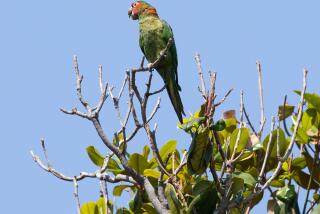AROUND HOME : Notes on Laundry Space, Dipped Candles, Tiffany Glass and Movado Watches : Sparrow Hawks
- Share via
ONE OF THE most beautiful hawks in the world lives and raises its families in the neighborhoods of Southern California. It is the sparrow hawk, sometimes called the kestrel.
Actually, the sparrow hawk is a diminutive falcon (as falcons go) and eats small items such as mice, grasshoppers, lizards and, of course, small birds such as sparrows. But being not much larger than a scrub jay, the sparrow hawk appears in turn on the menu of larger predators, including its cousin, the peregrine falcon, its more distant cousin, the Cooper’s hawk, as well as foxes, raccoons and house and alley cats. The sparrow hawk protects itself with a clever disguise. On the back of each side of its head are two large black spots. To the casual observer, these are just two markings that fit in with the little falcon’s gorgeous clothing--a rufous back, slate gray wings (on the male), orange tail with a black band across the end, edged with a strip of white, buff belly with bars (female) or spots (male), a reddish yarmulke atop the head, and a black mask with a tapered bar down through the eye. Behind the eyebar a second bar runs down through the ear. And behind the ear bars lie the spots, on the back of the head. They work like this:
A sparrow hawk sits on a neighbor’s roof. A mockingbird has spotted it and is harassing it mercilessly, hovering around the hawk’s head, growling and chucking. The hawk seems unconcerned. It looks away. But, no!--it is still looking at the mockingbird. Even though its beak is pointed in the opposite direction, the spots suggest eyes. No matter which way the hawk’s head is pointing, a pair of eyes is always on the alert. The mockingbird seems taken in by the ruse, because it acts very cautious as long as the spots point in its direction.
Later, the hawk sits on the ground in a back-yard garden. It has just finished eating a mouse and is settling back to bask in the sun and enjoy a rare moment of relaxation. It bends down to drink from a puddle. And at that instant, a white form leaps from behind a tomato plant, takes two great bounds, grabs the little hawk in its mouth, and dashes into the shrubbery along the fence. It is a cat--a young, inexperienced cat.
A few moments later, the hawk is free, sitting atop a telephone pole. The cat has discovered that the sparrow hawk has claws--sharp claws--and a strong beak. As a young cat, it didn’t appreciate the two eyespots peering up when the hawk bent over to drink. Next time the cat will notice such things. It is not wise to pounce on a sparrow hawk when it isn’t and is looking.
More to Read
Sign up for The Wild
We’ll help you find the best places to hike, bike and run, as well as the perfect silent spots for meditation and yoga.
You may occasionally receive promotional content from the Los Angeles Times.






